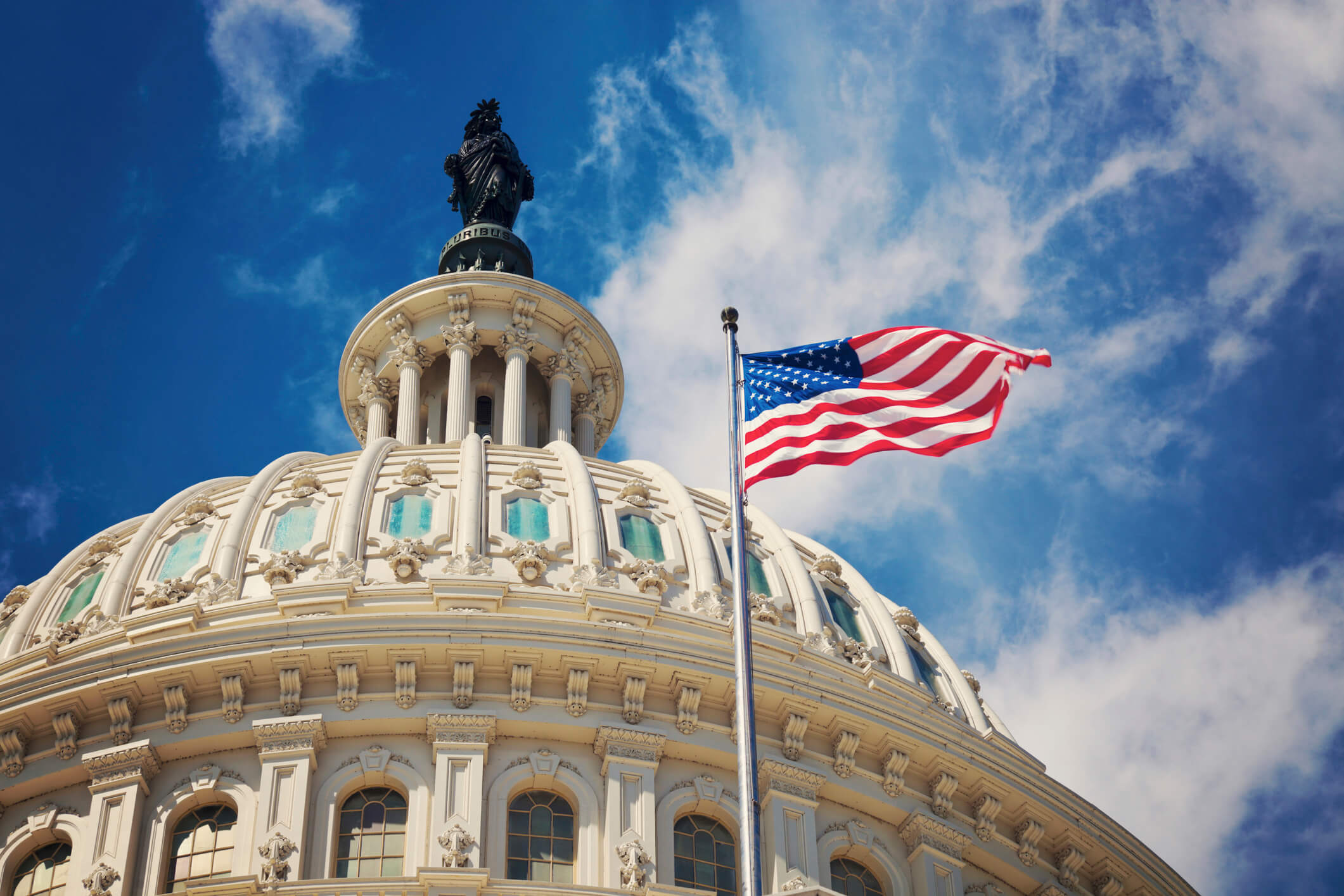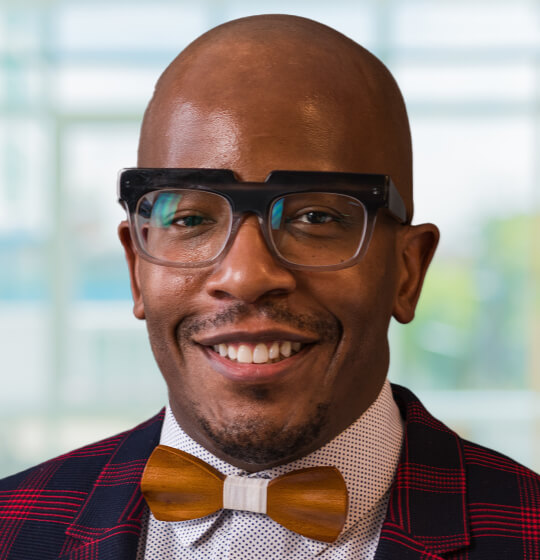In this inaugural episode of our EEOC Exclusive podcast series, Adam Dougherty (shareholder, Dallas) sits down with Jim Paul (shareholder, St. Louis and Tampa), D’Ontae Sylvertooth (shareholder, Washington) and Sean Oliveira (associate, St. Louis) to discuss the intricacies and processes of the U.S. Equal Employment Opportunity Commission (EEOC). The conversation focuses on the impact of the Supreme Court’s Loper Bright decision on EEOC regulations following the dismantling of Chevron deference, particularly in relation to the Prichard v. Long Island University case.
EEOC Exclusive: Looping in Loper Bright—The Discussion

Transcript
Announcer: Welcome to the Ogletree Deakins podcast, where we provide listeners with brief discussions about important workplace legal issues. Our podcasts are for informational purposes only and should not be construed as legal advice. You can subscribe through your favorite podcast service. Please consider rating this podcast so we can get your feedback and improve our programs. Please enjoy the podcast.
Adam Dougherty: All right. Thank you for joining us. My name is Adam Dougherty. I am a shareholder with Ogletree in our Dallas office. I’ve been practicing for about 25 years in employment law, which is hard to believe, board-certified in employment law, and just celebrated a full decade with Ogletree a couple of months ago.
And we’re glad that you can join us for our very first episode of our new podcast, the very exciting title of welcome to EEOC Exclusive. This podcast will be a recurring series regarding insider insights into the EEOC, how it works, how to respond, what certain types of communications likely mean from the EEOC, what drives the commission, and importantly this happened, what do we do next?
So, here with me today, I have several colleagues, including my official formal co-hosts, Sean and D’Ontae. Why don’t you guys introduce yourselves and tell us about your unique experience with the EEOC?
D’Ontae Sylvertooth: So, first of all, I want to thank you, Adam. My name is D’Ontae Sylvertooth. I’m a shareholder in the Washington, D.C. office of Ogletree. I’ve been practicing employment law for about 15 years now, maybe 14. But prior to that, I served as an EEOC investigator for several years and then also as a trial lawyer for EEOC for several years, and also litigated in the public sector related to EEOC, but representing agencies for quite some years as well. So happy to be here.
Sean Oliveira: Hi everybody. Thanks, Adam. This is Sean Oliveira. I’m an associate attorney in the St. Louis Ogletree Deakins office. Before that, for 15 years, I was an investigator with the EEOC. I started out in New York City, worked there for five years, worked a lot on systemic and class cases, and then moved here to St. Louis and worked in that office for 10 years as an investigator doing the same thing, basically. 2019, I started in the St. Louis Ogletree office, and I’ve been practicing employment law ever since.
Adam Dougherty: So, as we move forward in this series, we are going to have special episodes where we have special guests. And so, one of those special guests that we’re going to have here on our very first episode is Jim Paul. So, Jim, why don’t you tell us a little bit about yourself?
Jim Paul: Howdy, everybody. Thanks so much, Sean. I have been practicing for 30 years. Just in case anybody’s confused with that math, I went to law school when I was 12 years old, but I guess I’m the old guy today as a special guest for this podcast. I practice out of the Tampa office and the St. Louis office. Been with Ogletree for about 18 years now, when we opened the St. Louis office back then. So, I’m happy to join you guys today.
Adam Dougherty: Awesome. Thank you, sir. So, why are we having this episode? The episode is going to piggyback off of an article that the four of us recently wrote and published. Just to summarize that before we get y’all’s thoughts.
On July 30th, 2025, we had one of the first decisions concerning deference to EEOC regulations. Since the Supreme Court of the U.S. struck down Chevron deference in Loper Bright, a very important, really monumental decision. In this decision, we’re going to talk about the U.S. District Court for the Eastern District of New York in a case called Prichard v. Long Island University, which invalidated an EEOC regulation allowing it to issue right-to-sue notices on request before 180 days had passed.
So, first question, Sean, why don’t you take this one before we get into the details of the Second Circuit case? What EEOC practice did this case concern?
Sean Oliveira: Yeah, so what you want to know, really fast as an investigator, is that it’s impossible to handle all the cases that you get. They’re receiving thousands of charges a year, and oftentimes get sort of uneasy about how long it’s taking, and they want to go right to court and bypass the administrative process. And so, the EEOC, in order to help itself, in order to help plaintiffs’ attorneys, invented, sort of out of whole cloth, this way of getting an early right to sue. Basically, they can request a right to sue prior to 180 days, which is what statutes really require for them to wait. And as long as the EEOC can certify that it’ll take them longer than the remainder of the 180 days to finish the investigation, then they would just issue the right to sue early, and they could just go right to court.
Adam Dougherty: Okay. Did you see that happen often when you were an EEOC investigator?
Sean Oliveira: Yeah. Pro-state charging parties; almost never. But sure, every time that there was a plaintiff’s attorney who saw the EEOC as an obstacle, they would request the right to sue early, and they would almost always get it.
Adam Dougherty: D’Ontae, what was your experience like with the EEOC on this subject?
D’Ontae Sylvertooth: It varies from my experience. It depends on kind of what the allegations are in the charge, whether the individual is represented, whether the individual who was represented is represented by someone who was “annoying”, for lack of a better word. And so certainly if they are represented and the charge itself didn’t lead any credence to the EEOC, at least from my perspective, of continuing with the investigation, they would issue the notice right to sue fairly commonly. But there were sometimes, particularly for the office, that I worked in where that was pushed back on.
Sean Oliveira: We should point out too D’Ontae…sort of a strange little…even after the EEOC issues a right to sue again under the regulations, and maybe we can talk about this later about how valid that regulation is, but essentially they can keep investigating even after they issue of right to sue?
D’Ontae Sylvertooth: Correct. So, they can issue the right to sue, and because technically the EEOC is in the public interest, they can continue to investigate the charge unless and until someone challenges that decision, and there is some similar decision that rolls that back, but yes.
Adam Dougherty: Okay. So, at its core, is this really just a practice or is it a regulation?
D’Ontae Sylvertooth: So, it’s a regulation that is created by the EEOC, which essentially says that if a request is made for notice of right to sue less than 180 days, as long as the EEOC can verify. Now, what the regulation does not provide is what it means to actually verify that they cannot or cannot complete an investigation within the 180 days.
And the reason that’s important primarily is because Title VII gives the EEOC exclusive right to a charge once it’s filed for the first 180 days. And some of the other statutes that incorporate the EEOC…excuse me…the procedures within Title VII, such as the Americans with Disabilities Act, also require that it remain exclusive with the EEOC for 180 days. And that includes a FEPA, which is a fair employment practice agency, that the EEOC may provide the charge for investigation.
Adam Dougherty: Sean, did you have any additional thoughts to share?
Sean Oliveira: Yeah, I think you raise a good point by asking whether it’s a practice or a regulation. There is sort of lurking in the background…So for the EEOC, there’s the statutes that they’re working from, and then there’s the regulations that they’ve created to enforce the statute and to go along with the procedures of the statute as they interpret them. But then there’s further, an EEOC compliance manual and their guidance and all of that stuff, which are really sort of interpretations of the regulations, which are interpretations of the statute.
And so there are lots of examples that are sort of coming up as a result of Loper and the end of Chevron deference. Things that the EEOC does that would be considered practices, not necessarily regulations, that could be issues in the future. So just a couple of examples that I can think of off the top of my head.
They will often, in subpoenas or threats of subpoenas, talk about asking for nationwide information, or information that seems to go outside of what the charge is about. And the statute is really clear then that they have the authority to investigate the four corners of the charge. But in their regulations, especially in their compliance manual and in their guidance, they appear to take a position that they can ask for anything that’s minutely associated with or relevant to the issues that are raised in the charge outside of the four corners of the charge. That’s one example.
Another example is in their compliance manual and in their guidance, there are places where, when they’re requesting for information, the guidance says that they should first stop and think about whether they need that information. In other words, can they already dismiss the charge, or can they, fingers crossed against it, can they find cause already?
So, they’re not really opposed to it, according to their own guidance. They’re not really supposed to be asking for additional documents and that kind of stuff if they can already make a decision about the charge, but they rarely follow that guidance.
So, those are just a couple of issues with regard to practices you might say that are raised, I think kind of by your question, and as we’re thinking about Loper and the end of Chevron deference moving forward.
Adam Dougherty: Yeah. So, speaking of Loper, the reason for the season, so to speak, Jim, can you give us a background on that case and why it was so important?
Jim Paul: Sure. Yeah. In the Loper Bright Enterprises v. Raimondo case from last year, the U.S. Supreme Court issued an opinion that was a seismic disruption of administrative law, at least as we know it. And all of us, myself especially, are old enough to have been taught exclusively everything about the Chevron doctrine, which in a nutshell basically just established a whole body of administrative law and guidance that the courts are not supposed to be meddling in executive branch, administrative agency action or interpretation with regard to things that fall under their expertise. So, obviously, the Environmental Protection Agency and the Health and Human Services Division have very specific charges and duties that they’re supposed to be experts in.
And the U.S. Supreme Court in the Chevron case back in 1984, laid out a whole framework for, hey, we’re going to err on the side of trusting and following agency guidance and interpretation, especially when it comes to issuing regulations, guidelines, taking administrative enforcement action that is within its scope of expertise, whether that’s environmental law, labor relations, union law, employment law, health law, all of those different aspects, SEC, Securities Administration, OSHA, Health and Safety, Consumer Protection Services, all of those agencies have very specific background and expertise.
And so the court said, look, we’re not supposed to be meddling or interfering in that unless obviously the agency does something that’s completely outside its scope or unreasonable or in direct contradiction to statutory language. And so, what agencies usually do is they take very bare bones statutory language and then create volumes and volumes, hundreds and thousands or tens of thousands of pages of regulations that utilize and have compiled information again from experts in whatever particular field that agency or that regulation is addressing, and the court said that’s for the executive branch and for the administrative agencies to handle.
So along comes the Loper Bright decision last year, and basically cut the Chevron doctrine and that whole analysis off at the knees and said, hey, even if the agency was filling in or reasonably interpreting vague statutory language or guidance, we, the courts, get to say whether or not an agency’s regulation is reasonable or whether it should be enforced.
And so basically the U.S. Supreme Court said that now judges, instead of the administrative agencies, are going to be the ones that have the authority to interpret those regulations and decide whether and how they should be followed. And again, that’s almost a 180-degree turn. And putting aside which side of the aisle or which administration or which political party appointed a judge, it goes both ways, or it’s equally applied. Whether it’s a regulation or an agency action initiated by the Trump administration agencies or previously the Biden administration or any administration in the future, what the U.S. Supreme Court has done instead is that the judges are going to be the experts or can interpret that, not the agencies.
And so it’s not going to matter necessarily where the regulation came from or which administration; what’s going to matter is that judge’s determination on reasonableness or how to interpret that regulation.
Adam Dougherty: Awesome. That was an excellent summary there. So how does that Loper decision tie into the Prichard case?
Jim Paul: Yeah, so basically, Prichard took and ran with that authority from the U.S. Supreme Court, and the judge said, based on arguments from the parties, the defendant employer, and said, yeah, there is no statutory basis for the EEOC to have done what it has been doing for forever as far as issuing early right to see notices. And the judge said the statute…which is true. Nobody can really dispute that the statute’s very clear and sets up a very specific objective timeline and deadlines and process for administrative discrimination charges to go through the EEOC process and procedures.
And that requires that they sit either sit and nobody’s picked up the file or looked at it for 180 days, or it’s being investigated by the EEOC. Nothing can be done outside of the EEOC basically…and I’m simplifying it, so I know Sean and D’Ontae are going to potentially have a little bit of a nuance to this…but basically the statute says that it needs to stay there for 180 days whether something is accomplished or not. And then after that, the charging party, the employee, can request dismissal and a notice of right to sue, so that’s their ticket then to file a lawsuit in court.
But there really is no ifs, ands, or buts, at least on the statutory language and this practice that has been accomplished at the EEOC. And by the way, a lot of states have similar agencies. I think D’Ontae referred to those as FEPA agencies, the State Fair Employment Practices Agencies, and they have similar procedural timelines and deadlines and structure to the EEOC. So, we can’t forget about that there’s always an underlying state law issue, which we might talk about in a minute as well.
But that’s basically what the judge in this case did with regard to the 180-day requirement and said, nope, we can’t do anything in court. This needs to be dismissed. The EEOC has to take it and either sit on it or deal with it for the remainder of the 180 days.
Sean Oliveira: Jim, the only thing I would add there, you’re 100% right; I’m going to jump in and say there’s something else. So that leaves the only way out here for a plaintiff to get a right to sue before 180 days with the EEOC is for the EEOC to dismiss the case and issue a right to sue pre-180 days.
Adam Dougherty: So, guys, let’s say the employer wants to challenge a notice of right to sue that was issued at a charging party’s request. Why do you think an employer might want to actually challenge it to effectively send it back to the EEOC?
Jim Paul: Yeah, just real quick. Strategically, it’s kind of an important decision, and it depends on what the parties, specifically what a defendant employer wants to do. Do they want to try to get it settled, or do they want to just get to court and then fight it out and try to get it dismissed and get a judgment in court in its favor? If the latter, then the employer may not care that the right-to-sue letter was issued prematurely. They’d rather get on with it and go into court. Obviously, they don’t want to be in court and for the EEOC to also be simultaneously investigating. I’ll let Sean and D’Ontae talk about that potential scenario.
But on the other hand, if an employer wants to just make it more difficult for the employee or the employee’s attorney to get into court or to pursue a court action, then they’ll raise this issue and then delay it, and then who knows what might happen? It might settle. The plaintiff’s employee or the plaintiff’s attorney might go away or forget about it, and it might be just another roadblock to put up, maybe the fact that it winds up having the case go away. But a lot of times, the strategic decision could be we really don’t care. We’d rather it not be with the EEOC. We’d rather get on with all the action in court.
Adam Dougherty: Well, D’Ontae and Sean, definitely share your thoughts about that, but also share your perspective from having worked at the EEOC about how happy or sad is the EEOC going to be if the charge gets sent back to it, and could they potentially be biased against the employer that has that happen?
D’Ontae Sylvertooth: So, from my perspective, I’m going to take a more altruistic approach mainly because it was my philosophy when I was at the agency. So, my philosophy was and varies, other folks may have different experience, but as an investigator, I always thought my job was to try to be impartial and try to make a decision that serves the greater good or the greater interest, and that didn’t necessarily align with the charging party’s perspective, nor did it necessarily align with the employer perspective.
I don’t think one way or the other from my perspective, from a logistical standpoint, as to whether EEOC is going to be pissed off that the charges are there. One or two things are going to happen. They’re either going to investigate it or they’re just going to let it sit. If it sits, and it’s past the 180 days, then tada, you get to request your notice of right to sue. If again, the charge of party, or his or her attorney, is gung-ho about suing, on the 181st day, they may request that notice of right to sue.
But to answer the bigger question about strategy, I think part of it is you want it to go through the process. And so, part of that process is sitting because time changes perspectives. It could harden positions in the consultant positions. And so, if you have the time sitting in there, that may give the opportunity for the attorney, assuming the charge of parties represented, to then reach out to the organization and see if they can reach some kind of amicable settlement agreement. Or the other alternative is that you can use the EEOC investigator as a conduit for settlement as well and have those discussions. And some of it is you just don’t want it to be in the public domain at that particular point in time. And so, therefore, you decide that you want to go back and be remanded to the EEOC.
One last thing I would say on this, and I’ll let Sean, because I know Sean probably will have a lot to say. However, one alternative could be is that the EEOC can refer it to a FEPA. And quite frankly, a lot of FEPAs have very stringent regulations that I don’t think that this Loper decision will necessarily impact, but a lot of them have trial-like perspectives, and so the EEOC may send it to them so that there could be a public hearing, and a hearing on the merits of the case.
So, there are some positives to it, but also have some negative drawbacks depending on how the agency wants to respond.
Sean Oliveira: Yeah. Contrary to what D’Ontae just said about me, I’m going to be short on this, and say I pretty much agree with everything Jim and D’Ontae just said. I think the most obvious reason to get it set back is if you think there’s a good chance of settling at the administrative level and certainly there’s less leverage from the other side if you’re at the administrative level.
Whether the agency will be angry at the employer or not if they did this, it probably depends on the office. I’m sure D’Ontae would say this is exactly right. But while we talk about this agency as though it’s one agency, it’s really a bunch of fiefdoms. Each little fiefdom has its own district director, and it sort of has its own drive and the kind of numbers that it has to give Washington, D.C. So, some offices are going to be neutral about whether the case came back to them or not. And some are going to be really upset because it’s affecting their numbers essentially.
The other reason an employer might want to do this is a lot of times the way the system works…and then I’ll be quiet…the way the system works is you submit your position statement, that usually is happening within 180 days, and automatically the other side gets a copy of your position statement, and they’re asked to rebut the position statement. And oftentimes, what happens is rather than try to rebut the position statement and provide their own evidence, which would come to us in the end, if they file a lawsuit, they’ll just request a right to sue at that point because the writing’s on the wall.
So, one reason might be to put it back in the EEOC’s court, basically, in order to put it back in the plaintiff’s court to say, Hey, provide some evidence and substantiate your case at this point, or get the dismissal that’s coming to you.
Jim Paul: And one more thing real quick. That position statement and rebuttal works both ways. Maybe if you’re the employer, you don’t want to have to do a position statement for it to be used against you potentially, and you just want to wait for court. On the other hand, there could also be very strict deadlines, filing deadlines. Under the state law, as a lot of you know, oftentimes an employee will bring both federal and state law claims against an employer in court. And what could happen is if a case gets dismissed on this issue that came up in Prichard that the federal claim needs to be dismissed and then dealt with the EEOC for 180 days, it could be then the employee or the employee’s attorney have now messed up or missed or will have missed a state law filing deadline in the process if there was an earlier right to sue issued by a state agency. So, this could be a very technical and strategic decision, and there’s no right or wrong answer.
And then just to kind of close out. I think the big takeaway for the Prichard case is not necessarily this particular issue on the 180 days and how soon someone can request a right to sue…although as we’ve talked about, there’s lots of pros and cons, and it gives creative strategy options for employers now to make this argument…but what this is, this portends, I think…but curious everybody else’s viewpoint…this portends a real opportunity for both employees and employers, but from our perspective, mainly employers, to start always looking at and evaluating whether any particular position, regulation, guideline or decision by the EEOC, could be determined by a judge to be unreasonable or outside the bounds.
So, I think this is going to start a whole new era now that Chevron has been overturned, and we’re dealing with the Loper Bright analysis. And it may depend on the political persuasion of the judge. Yes, judges are impartial and are interpreting the law, but if the law is they get to make a decision on the agency’s regulation or interpretations or guidelines, then there’s a lot more opportunity to argue against some of the things that the EEOC does. So, I think that’s the big takeaway.
D’Ontae Sylvertooth: Sorry, Adam, I will just chime in very quickly. I agree wholeheartedly with that perspective.
I also just want to put in the atmosphere that Prichard, while it certainly identifies a way to attack a regulation by EEOC or any other agency, it’s also important to recognize that depending on what circuit you’re in, the availability of that attack may be limited because there may be decisions that actually relied upon Chevron deference, however, that particular judge in that particular decision made his own independent finding to substantiate that the agency’s position was reasonable. So, in that particular regard, Prichard and the aspect of Prichard, may not stand if, in fact, there is some kind of decisions that the judge did his independent analysis. That’s just something to also think about before attacking a regulation by the agency.
Sean Oliveira: Yeah, that’s a great point, D’Ontae. The courts are coming down in different ways. The judge in Prichard is certainly an advocate of what you and Jim are talking about, which is if previous cases were solely based upon Chevron deference, then it’s fine to overturn it. If the judges in the previous cases made an independent judgment, even though they also rely on Chevron deference, then it’s sand, or it could seem, except in exceptional circumstances. However, we’ve seen at least one circuit now just interpret Loper Bright to mean that all Chevron cases in the past still stand, while moving forward, we’re not going to use Chevron deference.
So we’re starting to see the split here, and I think it’s exactly right to point that out and say, hey, it depends on the circuit you’re in.
Adam Dougherty: Awesome guys. Well, I think that was some very insightful commentary. Did any of you guys have anything else to add before we close out?
D’Ontae Sylvertooth: The only one thing that I want to emphasize, and this is just very quick, and it may dovetail to some other later episode or what have you. But we did mention very early on about the fact that just because there is a notice of right to sue issued that it doesn’t preclude the commission from continuing to investigate.
But one other aspect of that that folks rarely recognize is that in the EEOC regulations, whether it is a notice of right to sue after a dismissal or even after the disposition of a case, whether it’s cause and the commission decides not to file suit, there is a regulation under both provisions that actually allows the EEOC to provide whatever assistance it deems necessary to that person who’s issued a notice or right to sue. And that can come in various aspects.
So, that’s just something to also recognize about the power and authority of the agency, and whether or not that particular provision may be challenged in the future.
Adam Dougherty: All right. Well, we’ve reached a historic moment because that concludes our very first episode of Exclusive EEOC. Thank you, Sean, D’Ontae, and our special guest, Jim.
Like we mentioned at the start, our plan is to provide practical insider information and tips for dealing with the EEOC in a regularly occurring podcast, with special episodes coming out hot and heavy as the situation is warranted. If you have any suggestions, dear listeners, for specific topics, whether from the most basic, like I’ve received my first EEOC charge, what do I do, to something that’s more complex, like this issue we discussed today, please email us to let us know. We certainly welcome your thoughts and comments as we move forward.
Thank you so much, and we hope you all have a great rest of your day.
Announcer: Thank you for joining us on the Ogletree Deakins podcast. You can subscribe to our podcasts on Apple Podcasts or through your favorite podcast service. Please consider rating and reviewing so that we may continue to provide the content that covers your needs. And remember, the information in this podcast is for informational purposes only and is not to be construed as legal advice.
Topics

Employment Tax
Environmental, Social, and Governance (ESG) initiatives involve unique and sometimes difficult challenges for employers that seek to develop and comply with these initiatives while minimizing the potential for audits, shareholder demands, litigation, and other adverse, reputational outcomes based on these ESG initiatives.






